rnest Dodd was born in Wellington, 1880, 16 years after his grandparents
Richard and Mary Dodd arrived from Bath, England, to setup a new life as brewers
in Dunedin. At the age of 24, Ernest married Edith Violet Wills in
1904 and had two children - Clifford and Lorna. Sadly, Edith died in 1909
from septicemia aged 27. A few years later, Ernest remarried to a Francis Ruby
Bolton and had a son, Kenneth Jack. Again, sadly, his second wife died in 1914
of turberculosis aged 26. After Ernest's death, Clifford went to live with the
Wills family of Eastbourne and Lorna lived in an orphanage. It's unknown what
happened to Jack but a man appeared on the doorstep of Clifford's house many years
later claiming to be a half-brother! It's possible that he was raised by the
Bolton's. Prior to WWI and enlistment, Ernie's profession was a Clerk for the New Zealand Shipping Company, in Wellington. He was a hard working front rower forward, or hooker, in the old 2-3-2 scrum formation and was the first member of the Wellington College Old Boys club (COB) to become a New Zealand representative. The college club has an interesting beginning; A meeting in 1897 chaired by the Headmaster, Joseph Firth, who was to become the first club president, decided to form both a rugby club. He was affectionately known as 'The Boss' being almost 2 meters tall and over 90kgs - a keen supporter of rugger! And so, Old Boys Football Club was born. 'The Boss' taught the boys of Wellington College to play rugby. He and rugby players, using picks, shovels and wheelbarrows, manually dug out a clay bank to form the No 3 ground, still in use as a Club pre-season training ground. No doubt, a young and excited Ernie Dodd was there swinging a pick and dreaming of rugby matches to come. Firth ‘believed in the virtues of manliness, toil, and duty in preference to ease and pleasure, and transmitted to his pupils abhorrence of slovenliness, sneaking, and all things mean and unworthy’. Many of these values were seen as necessary to equip young men for the challenges of fighting in a war. He would have influenced Ernie's values that saw him eventually step up to the Kingdom's call. Voluntary cadet groups existed in many schools, including Wellington College, prior to 1909 when the Defence Act introduced compulsory military training. This act required all boys aged between 12 and 14 to undergo 52 hours of physical training each year as Junior Cadets. Initially, this training was supervised by their teachers, although this was dropped in 1912. Many of the more than 1600 college old boys who served overseas during the war had learnt to handle a gun, salute and march in formation on the playing fields of the school. Students were even awarded merit certificates in bayonet instruction. 1898 saw the first club game played although the score was never officially recorded. They played the Wellington 'Melrose' team which could well have included Henry Dewar, another of the 13 All Blacks to die in WWI. That first season the Junior COB team played seven matches, won three, drew one and lost three. A commendable result for a new team with many young players, including Ernie Dodd. The Third Grade team included R. J. Seddon, known as Dick. He was the eldest son of one of New Zealand's most famous Prime Ministers, 'King Dick' Seddon. Dick Junior left to go to the Boer War along with Dave Gallaher, the 1905 'Originals' captain and was later killed in the Great War. A very junior (by 9 years) Bernard 'Tiny' Freyberg, was at the college during Ernie's time. Freyberg was to become one of NZ's most honoured soldiers - a VC winner, Division Commander and eventually Prime Minister. Both Dodd and Freyberg ended up playing rugby in the same team in 1907 for COB!! Reviewing the 1900 season, one sports writer commented: "The Old Boys were a source of surprise to many, the members of the team all being considered rather young for Senior Championship honours but playing with an immense amount of dash they were never beaten until the final whistle sounded no matter who they were playing. The calibre of our players - young as they were - was reflected by three of them, Ernie Dodd, Mona Thomson and Frank Johnson, being selected to all play for Wellington. Ernie's big break had happened at last! The original proposal for a playing uniform was to be the same black jersey as the College. This was refused by the Rugby Union because black was also the playing jersey of the Wellington Representative team. So a white jersey with the college monogram on the left breast, and white shorts became the WCOB playing colours. Later on the shorts, or 'knickers' as they were called then, were changed to being black in colour - by the narrowest of votes. As a 21-year old Dodd played in the national team's warm-up match against Wellington in 1901 before appearing in the 'unofficial' international four days later against the touring New South Welshmen. In 1904, Ernie played in the first Ranfurly Shield challenge when Wellington upset the team who had been first awarded the shield, Auckland. In 1905 they were also in the Wellington team which in turn lost the shield to Auckland. He played for the North Island in 1902 but was out of the national reckoning until 1905. The Wellington hooker played three games for the All Blacks. His sole test being against Australia in an 'official' test in Dunedin. The term 'official' referring to the fact that at the time, the Original NZ team was touring the UK and a 2nd national team had been officiated. It was that match that saw Dodd play in the same team as Hubert Turtill - another of the 13 All Blacks killed in WWI. Dodd played 45 matches for Wellington between 1901 and 1905, his period with the union ending when as a clerical worker with the New Zealand Shipping Company he was transferred to Timaru. Still in his 20s, he was then given life membership by his WCOB club to mark his distinction as its first national rep, or All Black, as the nickname became more widely used through the years. Dodd formed a formidable front row pairing at club and provincial levels with Eric Watkins. They were in the Wellington provincial side which played against the 1905 Originals before they left for their tour of Britain and France. Athletic Park was sodden! One reporter stated that "...if the weather had been fine, and the ground dry, we would have been treated to a splendid exposition of the Rugby game of football. Both teams were in fine trim, and fit to play for a kingdom." The Wellington team beat the Originals 3- 0 with fullback, George Spencer's conversion only missing by inches. In those days a try was worth 3 points and back then there was no such thing as video-replay so records show that it was either Spencer or Dodd who scored. It must have been a flurry of forwards! David Gallaher's forwards were thoroughly outplayed and controversy stirred about Dodd's omission from the All Blacks due to his fine form. He and fellow front-rower, Eric Watkins, were the best front-rankers in the colony. They both beat their opponents on the All Black side two out of three scrummages! While there were rumours that the NZ side were not playing 100% due to pre-tour injury concerns, they were generally accepted as a side with potential that should rise to the challenge in the 'old country'. Although in his late 30's, Dodd enlisted in WWI as a Rifleman. He set sail for Liverpool on 16 July 1917. On his way he was hospitalised on the ship for some disorder. On 17 June 1918, somewhere France a bullet creased his scalp and he was again hospitalised for three days before rejoining his unit. Then only two months later he contracted scabies and found himself back in hospital! In September 1918, about 12 mths after Ernie reached Europe, the tempo increased: Haplincourt, Bertincourt, Ruyaulcourt – all in ruins – and then the southern half of Havrincourt Wood, from the deep thickets of which on the 9th, the Division assaulted the Trescault Spur, the last position before the Hindenburg Line. The German armies were still not ready to concede the war. The Hindenburg Line was still a formidable obstacle to be overcome. It consisted of a series of inter-locking defensive systems of barbed wire and pill-boxes, with defence in depth from the creation of a number of defensive lines. Each line would have to be assaulted and held, before moving on to the next line of defence. For the New Zealand Division, their next objective was Havrincourt, one of a number of French villages that had to be seized as part of the Third Army's assault on the defences of the Hindenburg Line. There, the defence hardened. Elite German troops threw everything into the battle – flamethrowers in the front line, intense gassing of rear areas, heavy counter-battery fire – and the New Zealanders gained only a slight advantage in five days of bitter fighting, though this check cost the enemy heavy loss of their elite 'Jager' units. We know that in the days leading up to Ernie's death, he was part of an assault on Trescault Spur. They had to first deal with a section of the Wood, then an awkward 'switch' trench in the open, and finally another stretch of the timbered area which curved southwards and covered their first objective. They briefly held what was named 'Dead Man's Corner' but were driven out again by a strong German counter-offensive. Sometime on the 11th, during this initial battle, Ernie was shot through the throat by a German sniper's bullet and died from his wounds. His odds of surviving the next day wouldn't have been good either as there was more long-sustained close fighting on the 12th of September than the Division had experienced on any other single day since Gallipoli. Earnest had made the rank of Lance Sergeant just four days earlier. In the final offensive between 21 August and 6 November 1918 the New Zealand Division captured 8756 prisoners, 145 guns, three tanks and 1263 machine guns. Exactly two months after Ernie's death, although the New Zealanders did not realise it, their war was effectively over. At 11.00 a.m. on 11 November 1918, the fighting ceased, and the greatest war in history was finally over. During the war, with a mixture of pride and remorse, Ernie's old Headmaster and Rugby Club President, 'The Boss' - Joseph Firth, wrote letters of condolence to the families of each of the 222 old boys who were killed. When the armistice was declared in November 1918, he was observed standing on the steps overlooking the bottom field with tears running down his face. Unfortunately Firth did not live to see the unveiling of the Wellington Cenotaph that he had organised funding for through the Citizens' War Memorial Committee of which he was Chairman. He died on 13 April 1931, less than two weeks before its dedication on Anzac Day, 25 April. IF YOU HAVE ANY ADDITIONAL INFORMATION ABOUT ERNEST DODD, PLEASE CONTACT US AT info@nixonpictures.co.nz All Black statistics courtesy of the NZ Rugby Museum: |
Video, Television, Corporate, DVD Production and Filming. Based in Auckland, New
Zealand. From concept planning to filming to final output. Over 10 years experience. |
© 2001 Nixon Pictures. Site built & managed by Nixon Pictures. |
solo worldwide |
format required |
rates |
camera operator |
Find out what we're doing or about to do... |

L.B.I.P.P Qualified |
Award Winning |
Nixon Pictures chooses to use Rocket Rentals. |
View online a selection of video clips. |
NEWS |
We have just returned from Western Australia on a 2-week Gone Fishin' shoot. The
team visited Perth, Exmouth and Broome. |
2001 - Best Documentary 2001 - Best Script 2005 - AVA Silver medal |
Documentary making is our passion. Be it a personal ambition or part of someone
else's desire to tell the world their story - we will listen, shoot and give it
all the attention it deserves. Bruce Nixon |
Click to download a PDF version of our CV. |
Experienced & pleasant |
Competitive & flexible |
Able to provide any |
Can direct & operate |
Based in New Zealand |
'All Blacks At War: The First XIII' |
Rifle Brigade Serial Number 54336 Died Wednesday, 11 September 1918, France Age 38 Grave Metz-en-Couture Communal Cemetery Ref: IV.B.16. |
ERNEST HENRY DODD Born 21 Mar 1880, Wellington Parents Frederick Henery & Ada Mary Dodd Education Wellington College. Physical Height 5' 9" Province Wellington Rugby Club First made All Blacks from Wellington COB. AB# 83 Position Hooker All Black Debut 28 August 1901 v Wellington, Wellington aged 21 International Debut 2 September 1905 v Australia, Dunedin, aged 25. Last Test 2 September 1905 v Australia at Dunedin aged 25. Rank Lance Sergeant, 2nd Battalion, 3rd NZ |
The All Black Games that Dodd played. (+) = substitute; (-) = replaced |
1901 28 Aug vs Wellington at Wellington 24 - 5 31 Aug vs N.S.W. at Wellington 20 - 3 1905 2 Sept vs Australia at Dunedin 14 - 3 |
Points scored for the All Blacks Dodd did not score any points for the All Blacks Test Record by Nation Australia Totals |
P W D L t c p dg
pts |
1 1 - - - - - - - 1 1 0 0 0 0 0 0 0 |
E |
Ernest Dodd All Black 1901 |

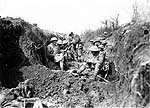
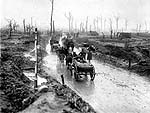
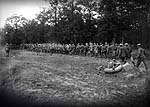
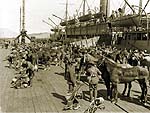
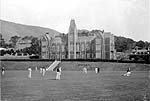
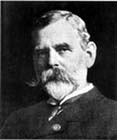
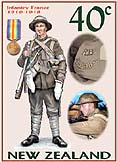

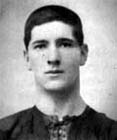
Joseph Firth 'The Boss' |
Wellington College |
COB Rugby Team 1899 |
SS Athentic |
Near the front lines - France 1918 |
NZRB rest in captured trench |
German Prisoners at Hindenburg Line |
NZRB Stamp |
Haverincourt Bunker - Today |
Metz-en-Couture Cemetery |
Or visit another of the 'First XIII' |
BACK TO MAIN MENU |
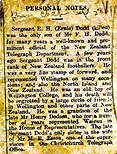
Death Notice - CHCH paper 28th Sept 1918 |
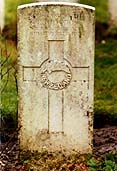
Ernest's Gravestone |
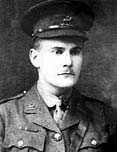
Bernard 'Tiny' Freyberg |
Last Updated Information - 05 March 2010 |